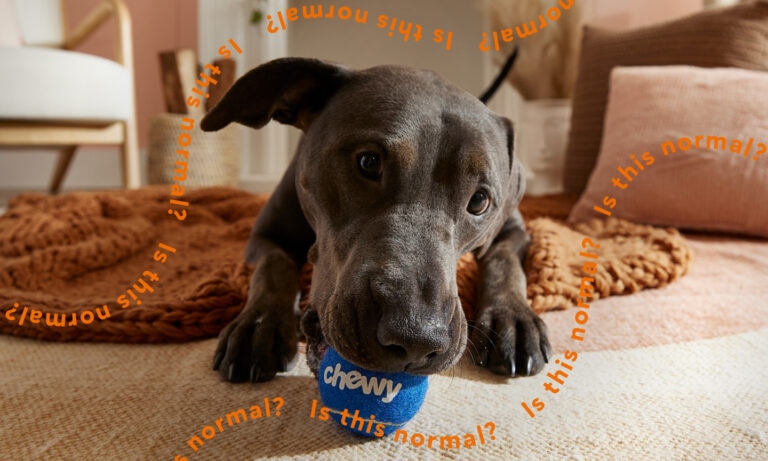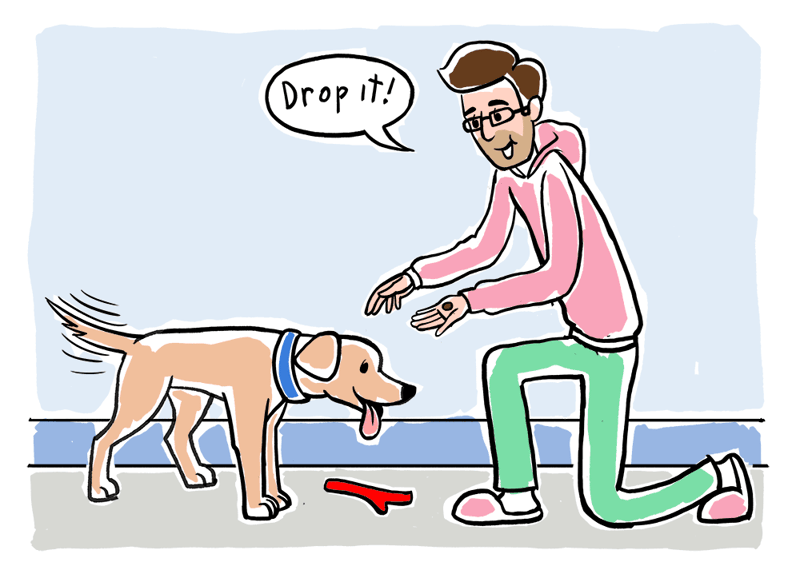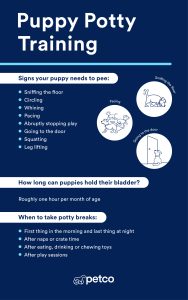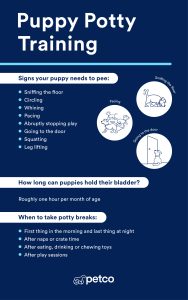Imagine the joy of watching your dog happily chase after a ball and bring it right back to you. Teaching your dog to fetch isn’t just fun—it strengthens your bond and gives your pet great exercise.
If you’ve ever wondered how to train your dog to fetch without the frustration, you’re in the right place. This guide will show you simple, step-by-step methods that anyone can follow. Keep reading, and soon your furry friend will be fetching like a pro!

Credit: www.chewy.com
Choosing The Right Toy
Picking the right toy is key when teaching your dog to fetch. The toy should be safe, fun, and easy to carry.
The right toy helps your dog enjoy the game and learn faster. Let’s look at what makes a good fetch toy.
Size And Shape
Choose a toy that fits your dog’s mouth comfortably. Too big or too small toys can cause problems.
A good fetch toy should be easy for your dog to carry without hurting their teeth or gums.
Material Safety
Select toys made from non-toxic and durable materials. Avoid toys that break easily or have small parts.
Safe materials keep your dog healthy and prevent choking hazards during playtime.
Texture And Grip
Pick toys with a texture your dog likes to chew and hold. Soft toys may work for gentle chewers.
Rubber or rope toys give better grip and last longer for active dogs that love to tug and fetch.
Visibility
Choose toys with bright colors. This helps your dog see the toy easily during play.
High visibility reduces the chance of losing the toy outside or in tall grass.
Type Of Toy
Different dogs like different toys. Balls, frisbees, and stuffed toys all work for fetching.
- Balls are classic and easy to throw
- Frisbees fly far and challenge your dog
- Stuffed toys are soft and cuddly

Credit: www.youtube.com
Creating A Positive Environment
Training your dog to fetch is easier when the environment feels safe and fun. A happy setting helps your dog focus and enjoy learning.
Positive energy encourages your dog to listen and try new things. It builds trust between you and your pet.
Use Encouraging Words And Tone
Speak with a cheerful and calm voice. Dogs respond well to kind words and happy tones.
Say simple praise like “Good job” or “Well done” to motivate your dog during training.
Offer Treats And Rewards
Use small treats to reward your dog when it fetches the object. Rewards make your dog want to repeat the behavior.
- Choose healthy, bite-size treats
- Give treats immediately after fetch
- Use treats only for training time
Keep Training Sessions Short And Fun
Limit each session to 5-10 minutes. Short sessions keep your dog interested and prevent boredom.
End training while your dog still wants to play. This makes your dog excited for next time.
Create A Safe Space
Train in a quiet, familiar place where your dog feels secure. Avoid loud noises or distractions.
Clear the area of items your dog might trip over or chew on. A safe space helps your dog focus on fetch.
Use Favorite Toys
Pick toys your dog likes for fetch training. A favorite toy keeps your dog excited and motivated.
- Soft balls
- Stuffed animals
- Rope toys
Teaching The Basic Commands
Training your dog to fetch is a fun way to build good behavior. It helps your dog listen and follow commands.
Start with simple commands. Teach your dog to understand and respond before moving on.
Introducing ‘fetch’ Command
Begin by showing your dog a toy or ball. Use the word “fetch” clearly as you throw it a short distance.
Encourage your dog to pick up the toy. Praise them when they do to make it a positive experience.
- Choose a favorite toy or ball
- Say “fetch” as you throw it
- Encourage your dog to grab the toy
- Praise your dog when they pick it up
- Repeat several times to build understanding
Using ‘drop It’ Command
Once your dog fetches the toy, teach them to drop it on command. Use the phrase “drop it” clearly.
Offer a treat or another toy as a reward when your dog drops the item. This helps them learn to let go.
- Hold a treat near your dog’s nose
- Say “drop it” firmly
- Wait for your dog to release the toy
- Give the treat or a different toy immediately
- Practice often to improve response
Starting With Short Distances
Teaching your dog to fetch begins with short distances. This helps your dog focus and understand the task.
Short throws build your dog’s confidence before trying longer throws. Keep sessions fun and easy.
Choose A Small, Easy Toy
Pick a toy your dog likes and can carry easily. Soft balls or small plush toys work well.
Make sure the toy is safe and not too big for your dog’s mouth.
Start Indoors Or In A Quiet Area
Begin training in a quiet place with few distractions. This helps your dog focus on you and the toy.
A small room or fenced yard works well for short fetch sessions.
Use Clear Commands
Use simple words like “fetch” or “get it.” Say the command clearly before you throw the toy.
Repeat the same command each time. This helps your dog learn faster.
Throw The Toy A Short Distance
Throw the toy just a few feet away. This distance is easy for your dog to reach quickly.
Encourage your dog to get the toy and bring it back to you.
Reward Your Dog Immediately
Give praise or a small treat when your dog brings the toy back. This shows good behavior.
Rewards help your dog want to play fetch again.
Keep Training Sessions Short
Train for five to ten minutes at a time. Short sessions keep your dog interested and not tired.
Stop before your dog loses focus to keep fetch fun and effective.
Encouraging Retrieval
Teaching your dog to fetch is fun and rewarding. Encouraging retrieval helps your dog enjoy the game.
Use simple ways to make your dog excited to bring the toy back to you. This builds good habits fast.
Using Treats And Praise
Treats and praise motivate your dog to fetch and return the toy. Give a small treat when they bring it back.
Say “good job” or use a happy voice to encourage your dog. This makes them want to please you again.
- Give a tasty treat right after return
- Use cheerful words and pet your dog
- Keep treats small to avoid overfeeding
- Be consistent with rewards every time
Playing Interactive Games
Interactive games make fetch exciting. Play in a way that keeps your dog focused and eager to retrieve.
Try tossing the toy a short distance at first. Cheer your dog on as they run and bring it back to you.
- Start with short throws and increase distance
- Use toys your dog loves
- Call your dog’s name to get attention
- Make the game lively and fun
Gradually Increasing Difficulty
Teaching your dog to fetch takes time and patience. You should increase the challenge little by little. This helps your dog learn without getting frustrated.
Start with easy tasks and slowly make them harder. This builds your dog’s skills and keeps the game fun and rewarding.
Extending Throw Distance
Begin by throwing the toy just a few feet away. Let your dog get used to fetching close by. When your dog is ready, throw the toy a bit farther each time.
Increase the distance slowly to avoid tiring your dog. This helps your dog build strength and focus on the fetch task.
- Throw 3-5 feet at first
- Then try 6-10 feet
- Move to 15 feet or more as your dog improves
- Always praise your dog for returning the toy
Adding Distractions
Dogs must learn to fetch even when things are happening around them. Start practicing in a quiet place. Then add small distractions like people walking by.
Increase distractions slowly so your dog stays focused. This helps your dog listen to you no matter what is going on.
- Practice inside with few distractions
- Try outside with quiet background noise
- Add more distractions like other dogs or kids
- Reward your dog for staying focused
Troubleshooting Common Issues
Training a dog to fetch can be fun but also tricky at times. Some dogs may not follow the steps easily.
This guide helps you fix common problems when teaching your dog to fetch. It covers two common issues.
Dog Doesn’t Bring Back Toy
Sometimes dogs like to chase the toy but do not bring it back. This can slow down training progress.
Try these tips to encourage your dog to return the toy:
- Use a toy your dog loves and is easy to carry.
- Call your dog excitedly when it has the toy.
- Reward your dog with treats or praise when it comes back.
- Practice short distances first, then increase gradually.
- Do not chase your dog; it may see this as a game.
Dog Loses Interest Quickly
Some dogs lose interest in fetching soon after starting. This can make training slow and frustrating.
Use these ideas to keep your dog engaged and eager to play:
- Keep training sessions short and fun, about 5 to 10 minutes.
- Change toys often to keep things fresh.
- Use treats as a reward to motivate your dog.
- Train in a quiet place with few distractions.
- End sessions on a positive note before your dog gets bored.
Maintaining Consistency And Patience
Training a dog to fetch takes time and steady effort. Consistency and patience help your dog learn better.
Dogs respond well to regular practice. Being patient makes the training process smooth and fun for both.
Keep Training Sessions Regular
Practice fetch every day at the same time. Short sessions work best to keep your dog focused.
Regular practice helps your dog remember what to do. It builds a habit of fetching the object.
- Train for 5 to 10 minutes daily
- Pick a quiet place without distractions
- Use the same commands every time
Use Clear And Simple Commands
Choose easy words like “fetch” or “bring.” Use these words consistently during training.
Clear commands help your dog understand what you want. Avoid changing words often to reduce confusion.
- Say the command with a calm voice
- Repeat the command each time
- Reward your dog when it follows commands
Be Patient With Your Dog’s Progress
Every dog learns at its own speed. Some take longer to fetch and return objects.
Stay calm and give your dog time to understand. Avoid rushing or getting upset during training.
- Celebrate small successes
- Give breaks if your dog seems tired
- Keep a positive attitude throughout training
Reward Consistent Behavior
Give treats or praise when your dog fetches correctly. Rewards encourage your dog to repeat good actions.
Use rewards right after your dog fetches. This links the action with positive feelings clearly.
- Use small, tasty treats
- Offer praise with happy words
- Use toys as rewards if your dog loves play

Credit: www.youtube.com
Frequently Asked Questions
How Long Does It Take To Train A Dog To Fetch?
Training a dog to fetch usually takes 1 to 2 weeks. Consistency and short daily sessions speed up learning. Each dog learns at its own pace, so patience is key for success.
What Is The Best Age To Start Fetch Training?
You can start fetch training as early as 8 weeks old. Puppies are eager to learn and play. Early training helps build good habits and strengthens your bond.
Which Commands Are Essential For Fetch Training?
Key commands include “fetch,” “come,” and “drop it. ” Clear, consistent commands help your dog understand the game. Use positive reinforcement to encourage correct behavior.
How Do I Keep My Dog Motivated During Fetch?
Use favorite toys and treats as rewards. Praise your dog enthusiastically to boost excitement. Keep sessions fun and short to maintain interest and energy.
Conclusion
Training your dog to fetch is rewarding and fun. Patience and consistency are key. Start with short sessions to keep your dog engaged. Use their favorite toy for motivation. Praise them when they do well. Fetch strengthens your bond and keeps your dog active.
Remember, practice makes perfect. Every dog learns at their own pace. So, stay patient and enjoy the process. You’ll both love the results. Happy fetching!

Emily Barker is the founder of ChillDogLife.com, a space dedicated to helping pup parents discover the best dog products, lifestyle tips, and cozy ideas for happier homes.
A lifelong dog lover, Emily combines her passion for pets with a knack for research to share trusted recommendations on everything from toys and furniture to health and everyday care.
Her goal is simple: to make life easier, stylish, and more joyful for dogs and the people who love them.







